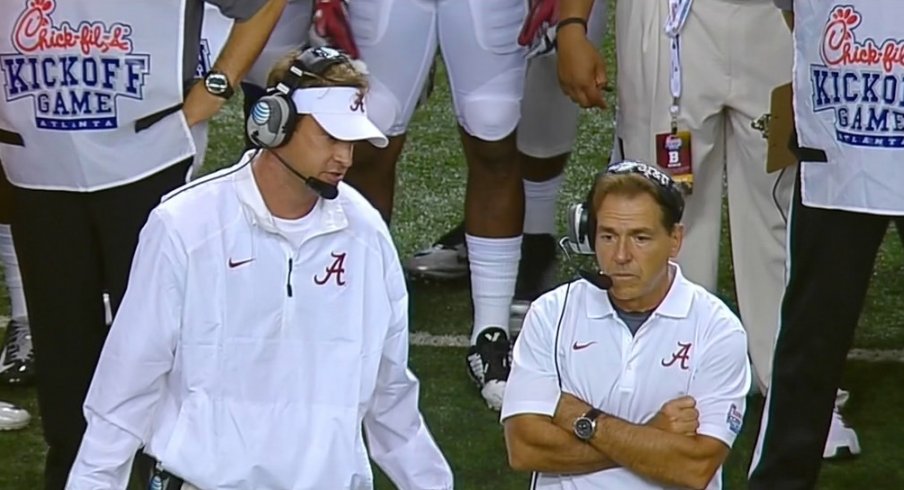The Alabama offense has enjoyed a late season resurgence under first year offensive coordinator Lane Kiffin. Although Kiffin has shifted the Crimson Tide to more shotgun spread looks to utilize the talents of his mobile fifth year senior quarterback Blake Sims and all-american wide receiver Armari Cooper, the offense's core remains the same -- a physical downhill zone run game.
And most plays to Cooper build upon that run game. So any defense looking to contain the Tide must first and foremost prevent Kiffin and Alabama from successfully running the football.
THe Odyessy
Kiffin's journey to his current position under head coach Nick Saban is well-known. But beneath the soap opera is a coach with a mix of NFL and college experience that meshed well with Saban's philosophy.
Kiffin's formative coaching years were spent in the West Coast offense. At USC, he combined a pro-style passing and zone run game with an increasing emphasis on spread concepts such as wide receiver screens.
Saban turned to Kiffin because of this mix. Under previous coordinator Doug Nussmeier, the Crimson Tide also utilized a pro-style framework.
But the Tide were more run-heavy than any NFL squad. Alabama frequently deployed 12 personnel -- 1 deep tailback with 2 tight ends -- to run base run plays such as inside zone, outside zone, and power. But Saban apparently tired of Nussmeier, leading to a mutual departure.
Enter Kiffin. For Saban, Kiffin perhaps offered the best of both worlds. Kiffin could refresh the offense by using more spread formations and motions to better attack the defense horizontally.
Yet Saban's first requirement was to maintain a physical zone run game. Kiffin utilized the downhill pro-style run game that Saban required.
This will remain the signature aspect of the Crimson Tide offense so long as Saban is the head coach. So even with Cooper's exploits inside zone and outside zone remain the core.
We're Talking Double Teams
Like Ohio State, inside zone remains Alabama's base run play. At its most basic, inside zone is a method to create double teams against any defensive front.
Every offensive linemen determines whether they are covered or uncovered. At the snap, every linemen takes an aggressive half step play side. A covered offensive lineman punches to the play side shoulder of the defensive lineman. He engages and waits for his backside uncovered counterpart to double team and overtake the defensive linemen. Once the uncovered linemen's block is established, one of the two linemen will come off to block the nearest linebacker. By blocking an area rather than a man, an offense can readily adjust to a variety of blitzes and stunts.
Inside zone is a perfect fit for Alabama's large, talented offensive lines and the physicalness and vision of its tailbacks -- this year consisting of TJ Yeldon and Derrick Henry.
As noted, Kiffin has not changed Alabama's reliance upon this play. Instead, he has increased the variety of ways the Crimson Tide run tight zone. Under Nussmeier, Alabama nearly always ran the play to a deep back.
But Kiffin increasingly calls the play from shotgun spread sets to an offset halfback. And those runs are frequently packaged with the threat of screens or quick slants to Cooper to constrain the defense.
Kiffin also extensively relies upon split zone. With split zone the offensive line's responsibilities remain the same. The only difference is that a tight end or back blocks away from the play to seal the backside end man on the line of scrimmage. This creates a natural cut-back lane for Alabama's talented backs.
Kiffin again uses different formations and motion to prevent the defense from overplaying split zone to a particular side of the shotgun formation. In particular, Kiffin often shifts from single back to two-back sets and vice versa to change from run-first to pass-first formations and force defenses to alter their coverages to account for the change in number of receivers.
For instance against rival Auburn, Kiffin had fullback Jaston Fowler motion into the backfield. Simms gave to Fowler, with Yeldon serving as the backside blocker.
The motion shifted the offense to a more run-heavy look. And using Yeldon as a blocker prevented the defense from overly keying on the tailback.
Stretchin 'Em Wide
Once a defense overly concentrates on the inside run Alabama turns to outside zone. As with inside zone, outside zone relies upon the same covered-uncovered rules. But the offensive line takes more lateral steps. The goal is to get the defense moving laterally, creating lanes for the tailback to cut upfield.
Alabama also utilizes a toss pin and pull version of the play from under center, particularly when they want to get the football to the edge.
The Crimson Tide is most dangerous when Cooper is getting the football in space. But Cooper is able to obtain that space because teams must commit to stopping the run. So as with the Ohio State offense, the first order of business for any defense is limiting the Crimson Tide run game and forcing Simms into must pass situations.
Next week I will examine the Tide passing game and how opposing defenses have defended the Alabama offense.


